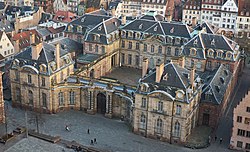| Palais Rohan | |
|---|---|
 Aerial view from the Strasbourg Cathedral viewing platform, January 2020 | |
| Alternative names | Palais des Rohan, Palais des Rohans |
| General information | |
| Type | Palace |
| Architectural style | Baroque |
| Location | Strasbourg, France |
| Address | 2, place du Château, 67000 Strasbourg |
| Coordinates | 48°34′51″N 7°45′08″E / 48.58083°N 7.75222°E |
| Current tenants | Archaeological Museum, Museum of Fine Arts, Museum of Decorative Arts |
| Construction started | 1732 |
| Completed | 1742 |
| Owner | Municipality of Strasbourg |
| Design and construction | |
| Architect(s) | Robert de Cotte, Joseph Massol |
| Website | |
| www | |
The Palais Rohan (Rohan Palace) in Strasbourg is the former residence of the prince-bishops and cardinals of the House of Rohan, an ancient French noble family originally from Brittany. It is a major architectural, historical, and cultural landmark in the city.[1] It was built next to Strasbourg Cathedral in the 1730s, from designs by Robert de Cotte, and is considered a masterpiece of French Baroque architecture.[2][3] Since its completion in 1742, the palace has hosted a number of French monarchs such as Louis XV, Marie Antoinette, Napoleon and Joséphine, and Charles X.
Reflecting the history of Strasbourg and of France, the palace has been owned successively by the nobility, the municipality, the monarchy, the state, the university, and the municipality again. Its architectural conception and its iconography were intended to indicate the return of Roman Catholicism to the city, which had been dominated by Protestantism for the previous two centuries. Thus the prelate's apartments face the cathedral, to the north, and many of the statues, reliefs and paintings reflect Catholic dogma.[4]
Since the end of the 19th century the palace has been home to three of Strasbourg's most important museums: the Archaeological Museum (Musée archéologique, basement), the Museum of Decorative Arts (Musée des arts décoratifs, ground floor) and the Museum of Fine Arts (Musée des beaux-arts, first and second floor). The municipal art gallery, Galerie Robert Heitz, in a lateral wing of the palace, is used for temporary exhibitions. The Palais Rohan has been listed since 1920 as a Monument historique by the French Ministry of Culture.[5]
- ^ "Le Palais Rohan". Musées de la ville de Strasbourg. Retrieved 27 February 2016.
- ^ Johnson, Paul (24 May 2006). "The message of a great European cathedral". The Spectator.
- ^ Sherwood, Seth (17 December 2014). "36 Hours in Strasbourg, France". The New York Times.
- ^ Borda d'Água, Flávio (Summer 2013). "Le Palais Rohan : un joyau princier au coeur de Strasbourg". La Gazette des Délices.
- ^ Base Mérimée: Palais des Rohan, actuellement Musée archéologique et Musée des Beaux Arts et Arts Décoratifs, Ministère français de la Culture. (in French)
